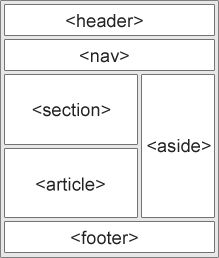HTML Layout & Sections
Semantic Sectioning Elements
HTML5 introduced several semantic elements that define different parts of a web page. These elements make your HTML more readable and help with accessibility and SEO.

Image source: W3Schools. © W3Schools. Used with permission.
Semantic elements clearly describe their meaning to both the browser and the developer. Examples include:
<header>- Defines a header for a document or a section<nav>- Defines a container for navigation links<main>- Specifies the main content of a document<section>- Defines a section in a document<article>- Defines an independent, self-contained content<aside>- Defines content aside from the content (like a sidebar)<footer>- Defines a footer for a document or a section
The <header> Element
The <header> element represents a container for introductory content or a set of navigational links.
<header>
<h1>Site Title</h1>
<p>Site tagline or description</p>
<nav>
<ul>
<li><a href="#">Home</a></li>
<li><a href="#">About</a></li>
<li><a href="#">Contact</a></li>
</ul>
</nav>
</header>
A <header> typically contains:
- One or more heading elements (
<h1>-<h6>) - Logo or icon
- Authorship information
- Navigation menu (often wrapped in a
<nav>element)
You can have multiple <header> elements in one document. However, a <header> cannot be placed within a <footer>, <address> or another <header> element.
The <nav> Element
The <nav> element defines a set of navigation links. It should be used only for major navigation blocks.
<nav>
<ul>
<li><a href="#">Home</a></li>
<li><a href="#">Products</a></li>
<li><a href="#">Services</a></li>
<li><a href="#">About</a></li>
<li><a href="#">Contact</a></li>
</ul>
</nav>
Not all links in a document should be inside a <nav> element. The <nav> element is intended only for major blocks of navigation links. Typically, the <footer> element often has a list of links that don't need to be in a <nav> element.
The <main> Element
The <main> element specifies the main content of a document. The content inside the <main> element should be unique to the document and should not include content that is repeated across documents such as sidebars, navigation links, copyright information, site logos, and search forms.
<main>
<h1>Most Popular Browsers</h1>
<p>Chrome, Firefox, and Edge are the most used browsers today.</p>
<article>
<h2>Google Chrome</h2>
<p>Google Chrome is a web browser developed by Google, released in 2008.</p>
</article>
<article>
<h2>Mozilla Firefox</h2>
<p>Mozilla Firefox is an open-source web browser developed by Mozilla.</p>
</article>
</main>
There must not be more than one <main> element in a document. The <main> element must not be a descendant of an <article>, <aside>, <footer>, <header>, or <nav> element.
The <section> Element
The <section> element defines a section in a document. According to the HTML5 documentation, "a section is a thematic grouping of content, typically with a heading."
<section>
<h2>WWF History</h2>
<p>The World Wide Fund for Nature (WWF) is an international organization working on issues regarding the conservation, research and restoration of the environment.</p>
</section>
<section>
<h2>WWF's Mission</h2>
<p>The World Wide Fund for Nature (WWF) mission is to stop the degradation of our planet's natural environment, and build a future in which humans live in harmony with nature.</p>
</section>
A website could normally be split into sections for introduction, content, and contact information. It's a good practice to use heading elements to define the theme of a section.
The <article> Element
The <article> element specifies independent, self-contained content. An article should make sense on its own and it should be possible to distribute it independently from the rest of the site.
<article>
<h2>Google Chrome</h2>
<p>Google Chrome is a web browser developed by Google, released in 2008.</p>
</article>
<article>
<h2>Mozilla Firefox</h2>
<p>Mozilla Firefox is an open-source web browser developed by Mozilla.</p>
</article>
Examples of where an <article> element can be used:
- Forum posts
- Blog posts
- News stories
- Product cards
- User-submitted comments
The <aside> Element
The <aside> element defines content that is tangentially related to the content around it. It is often presented as a sidebar or callout box.
<p>My family and I visited The Epcot center this summer.</p>
<aside>
<h4>Epcot Center</h4>
<p>Epcot is a theme park at Walt Disney World Resort featuring exciting attractions, international pavilions, award-winning fireworks and seasonal special events.</p>
</aside>
The <aside> element can be used for:
- Sidebars
- Pull quotes
- Advertising
- Groups of navigation elements
- Other content that is considered separate from the main content
The <footer> Element
The <footer> element defines a footer for a document or section. A <footer> typically contains authorship information, copyright information, contact information, sitemap, back to top links, and related documents.
<footer>
<p>Author: John Doe</p>
<p><a href="mailto:john@example.com">john@example.com</a></p>
<p>© 2023 My Website. All rights reserved.</p>
</footer>
You can have several <footer> elements in one document. A <footer> element cannot be placed within a <header>, <address> or another <footer> element.
Common Layout Patterns
Basic Page Layout
<body>
<header>
<h1>Website Title</h1>
<nav>
<!-- Navigation links -->
</nav>
</header>
<main>
<section>
<h2>Section Title</h2>
<p>Section content...</p>
</section>
<section>
<h2>Another Section</h2>
<p>More content...</p>
</section>
</main>
<footer>
<p>© 2023 My Website</p>
</footer>
</body>
Two-Column Layout with Sidebar
<body>
<header>
<!-- Header content -->
</header>
<div class="container">
<main>
<article>
<!-- Main content -->
</article>
</main>
<aside>
<!-- Sidebar content -->
</aside>
</div>
<footer>
<!-- Footer content -->
</footer>
</body>
Blog Post Layout
<body>
<header>
<!-- Site header -->
</header>
<main>
<article>
<header>
<h1>Blog Post Title</h1>
<p>Posted on <time datetime="2023-04-21">April 21, 2023</time> by Author</p>
</header>
<section>
<!-- Post content -->
</section>
<footer>
<!-- Post tags, categories, etc. -->
</footer>
</article>
<aside>
<!-- Related posts, categories, etc. -->
</aside>
</main>
<footer>
<!-- Site footer -->
</footer>
</body>
Best Practices for Layout & Sections
- Use semantic elements to structure your content appropriately
- Don't use semantic elements just for styling purposes
- Use
<div>elements when no other semantic element is appropriate - Include headings in sections and articles to define their theme
- Ensure your layout is accessible by using proper heading hierarchy
- Use the
<main>element only once per page - Nest elements appropriately according to the HTML5 specification
- Use CSS for layout styling, not HTML table elements
- Test your layout on different screen sizes to ensure responsiveness